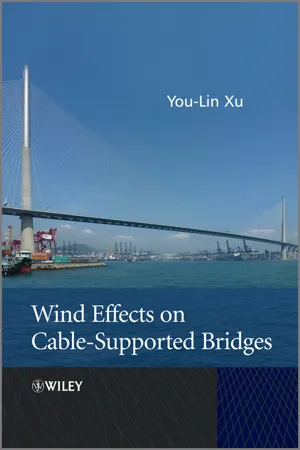
- English
- ePUB (mobile friendly)
- Available on iOS & Android
Wind Effects on Cable-Supported Bridges
About This Book
As an in-depth guide to understanding wind effects on cable-supported bridges, this book uses analytical, numerical and experimental methods to give readers a fundamental and practical understanding of the subject matter. It is structured to systemically move from introductory areas through to advanced topics currently being developed from research work. The author concludes with the application of the theory covered to real-world examples, enabling readers to apply their knowledge.
The author provides background material, covering areas such as wind climate, cable-supported bridges, wind-induced damage, and the history of bridge wind engineering. Wind characteristics in atmospheric boundary layer, mean wind load and aerostatic instability, wind-induced vibration and aerodynamic instability, and wind tunnel testing are then described as the fundamentals of the subject. State-of-the-art contributions include rain-wind-induced cable vibration, wind-vehicle-bridge interaction, wind-induced vibration control, wind and structural health monitoring, fatigue analysis, reliability analysis, typhoon wind simulation, non-stationary and nonlinear buffeting response. Lastly, the theory is applied to the actual long-span cable-supported bridges.
- Structured in an easy-to-follow way, covering the topic from the fundamentals right through to the state-of-the-art
- Describes advanced topics such as wind and structural health monitoring and non-stationary and nonlinear buffeting response
- Gives a comprehensive description of various methods including CFD simulations of bridge and vehicle loading
- Uses two projects with which the author has worked extensively, Stonecutters cable-stayed bridge and Tsing Ma suspension bridge, as worked examples, giving readers a practical understanding
Frequently asked questions
Information
Table of contents
- Cover
- Title Page
- Copyright
- Dedication
- Foreword
- Foreword
- Preface
- Acknowledgements
- Chapter 1: Wind Storms and Cable-Supported Bridges
- Chapter 2: Wind Characteristics in Atmospheric Boundary Layer
- Chapter 3: Mean Wind Load and Aerostatic Instability
- Chapter 4: Wind-Induced Vibration and Aerodynamic Instability
- Chapter 5: Wind-Induced Vibration of Stay Cables
- Chapter 6: Wind-Vehicle-Bridge Interaction
- Chapter 7: Wind Tunnel Studies
- Chapter 8: Computational Wind Engineering
- Chapter 9: Wind and Structural Health Monitoring
- Chapter 10: Buffeting Response to Skew Winds
- Chapter 11: Multiple Loading-Induced Fatigue Analysis
- Chapter 12: Wind-Induced Vibration Control
- Chapter 13: Typhoon Wind Field Simulation
- Chapter 14: Reliability Analysis of Wind-Excited Bridges
- Chapter 15: Non-Stationary and Non-Linear Buffeting Response
- Chapter 16: Epilogue: Challenges and Prospects
- Index